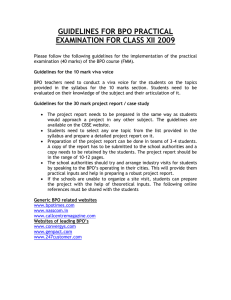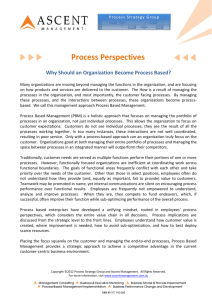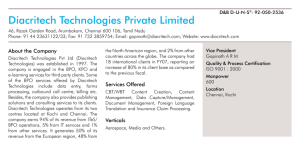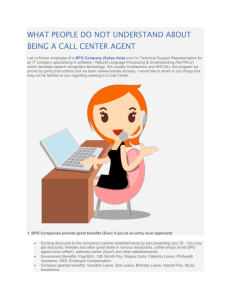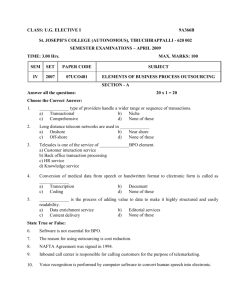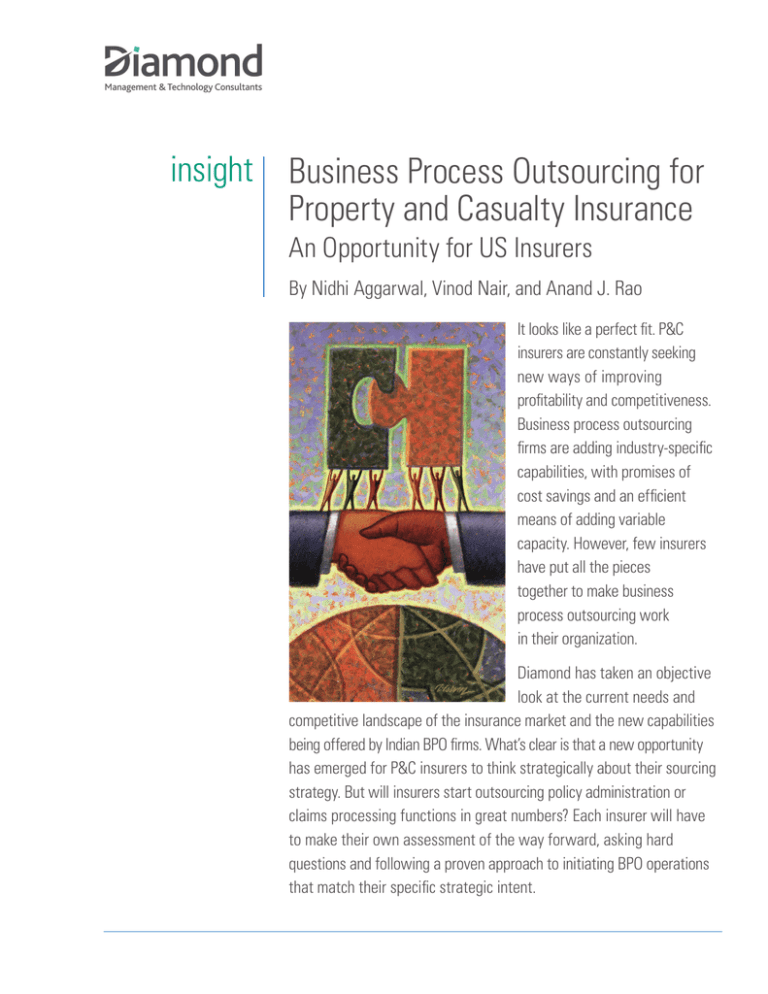
insight
Business Process Outsourcing for
Property and Casualty Insurance
An Opportunity for US Insurers
By Nidhi Aggarwal, Vinod Nair, and Anand J. Rao
It looks like a perfect fit. P&C
insurers are constantly seeking
new ways of improving
profitability and competitiveness.
Business process outsourcing
firms are adding industry-specific
capabilities, with promises of
cost savings and an efficient
means of adding variable
capacity. However, few insurers
have put all the pieces
together to make business
process outsourcing work
in their organization.
Diamond has taken an objective
look at the current needs and
competitive landscape of the insurance market and the new capabilities
being offered by Indian BPO firms. What’s clear is that a new opportunity
has emerged for P&C insurers to think strategically about their sourcing
strategy. But will insurers start outsourcing policy administration or
claims processing functions in great numbers? Each insurer will have
to make their own assessment of the way forward, asking hard
questions and following a proven approach to initiating BPO operations
that match their specific strategic intent.
Executive
Summary
table of contents
The Need for BPO . . . . . . . . . 3
Understanding the Indian BPO Sector
Engaging BPO Providers
The Way Forward
Conclusion
. 5
. . . . . . . . 9
. . . . . . . . . .
12
. . . . . . . . . . . . .
13
About the Firm and Authors
. . . . . .
14
For more information contact:
Paul Blase, Co-Managing Partner,
Insurance Practice
paul.blase@diamondconsultants.com
Jamie Yoder, Co-Managing Partner,
Insurance Practice
james.yoder@diamondconsultants.com
Vinod Nair, Managing Partner,
India
vinod.nair@diamondconsultants.com
2
While U.S. property and casualty (P&C)
insurers have made significant headway in IT
outsourcing, business process outsourcing
(BPO) is still largely unexplored. With premiums
expected to grow at 2–3%1 annually, there
is a greater need to structure expenses
for a soft market. P&C insurers therefore need
to find new avenues to reduce expenses
and add variable capacity. BPO is an effective
way to source fresh talent from a pool of
resources that can be increased, decreased,
or moved to higher priority work streams.
This would allow the business to add capacity
where and when required and focus on
aggressive growth initiatives while keeping
salary expenses in check. According to
Diamond’s estimates, BPO offers a potential
cost savings of approximately 35% to
the original cost basis of processes, with
an additional 10% possible depending
upon volume or complexity of processes
outsourced.
India is a logical destination to turn to
in looking for outsourced skills. In fact, over
the past 12 months Indian BPO providers
have reported an increase in enquiries
from U.S. P&C insurers. But contracts
of significant size have not been reported
during this period, indicating that insurers
either are not convinced about the
value proposition offered by BPO or have
limited understanding about BPO service
providers. Moreover the plethora of services
offered by BPO service providers does
not paint a clear picture—either about
capabilities within P&C insurance or models
to engage providers.
Diamond believes that business process
outsourcing—particularly in India—
has matured to the point that it can be
considered a viable element of an overall
sourcing strategy for P&C insurers. In this
paper we: (1) quantify opportunities to
reduce expenses and add variable capacity,
(2) review the current capabilities of
Indian providers aiming to serve the U.S.
P&C market and (3) provide insight on
models to engage providers successfully.
The Need for BPO:
Slow Top Line Growth
and a Greater Need
to Control Expenses
Industry experts predict strong financial
performance among P&C insurers, primarily
due to substantially lower catastrophic losses
in 2006 when compared to 2004 and 2005.
However, challenges to profitability still exist,
including stagnant premium growth in a
soft market, particularly in the personal and
commercial lines pricing environment.
Top line growth estimated for 2006 is merely
3.3%. Though this is an improvement over the
0.4% Net Written Premium (NWP) growth in
2005 (Figure 1), the industry forecasts growth
to remain sluggish—between 2–3%1. Expense
ratio, estimated to be 26% in 2006, has
risen over the past 3 years (Figure 1). Therefore,
there is a greater need for insurers to structure
underwriting expenses for a soft market.
Underwriting expenses can be classified
in the following five expense categories:
• Commissions & Brokerage
Commissions and brokerage account
for nearly half of total underwriting
expenses. P&C insurers have implemented
new commission structures, enabling
technologies, and distribution strategies
in an effort to limit expenses related to
commissions and may find it difficult to further
reduce costs. Salaries and wages are a
large and growing component of underwriting
expenses, consistently accounting for a
fifth of underwriting expenses and growing
from 18% of underwriting expenses to
21% between 2003 and 2005 (Figure 2).
The increase in workforce and pay scales
are major contributors to the growth of
expenses, as evidenced by the growth
of 5.3% CAGR in average salary per employee
within the insurance industry between
2000 and 20042. The average hourly wage
rate for all occupations in the U.S. grew only
at 3.4% CAGR during the same period.
U.S. P&C insurers are likely facing a soft
market, declining premium rates, and fierce
competition, a situation that demands
careful control of the levers of profitability. The
ability to manage risks and control expenses
• Taxes, Licenses, & Fees
• Advertising
• Administration & Equipment
• Salaries & Wages
Net Written Premium (NWP) Growth Rate and Expense Ratio for U.S. P&C Insurers
% Growth
Rate
Expense
Ratio
15%
28
14.1%
NWP Growth Rate
(Current $)
27
Expense Ratio
9.8%
10%
8.1%
26
5.1%
5%
4.7%
3.3%
25
1.9%
0.4%
0%
1999
2000
2001
2002
2003
2004
2005
2006E
24
Source: Insurance Information Institute and A. M. Best
Figure 1
3
will be critical and in that regard, BPO can
offer an efficient means of shifting, adding
or decreasing resources. Business process
outsourcing can also be a means to promote
growth, such as by adding flexible capacity
to support policy acquisition, pricing and
issuance. In addition to helping scale existing
products and processes, BPO could allow
insurers to focus on developing more complex
products. For instance, driving the growth
of product offerings within surplus lines could
help insurers weather a softer market.
Opportunities for Reducing Costs
and Adding Variable Capacity
Outsourcing is effective in reducing
salary expenses and building variable
operational capacity from a fresh
talent pool. IT divisions within P&C insurers
have done this effectively by leveraging
IT outsourcing service providers, even while
migrating to newer IT platforms to further
reduce underwriting expenses. Since 2001,
overall IT spending within the insurance
industry has declined consistently. By 2005
IT spending represented only 3.1% of
revenue for insurers3. This success with IT
outsourcing has not prompted insurers
to test BPO’s potential. Insurers seem
concerned that business process outsourcing
might lead to losing operational control and
cause consumer or legislative backlash.
Beyond the benefit of additional variable
capacity, insurers can also realize potential cost
savings of up to 45% by outsourcing business
processes (Figure 3). The cost advantage is
primarily driven by reduction in labor costs—
approximately 35% for qualified professionals
in India as compared to their U.S. counterparts.
Savings in training costs could be up to 5%,
with an additional 5% savings on infrastructure
costs (office space lease, equipment lease,
maintenance, etc). Insurance carriers can
further maximize the value of their outsourcing
efforts by optimizing processes before they
are outsourced. Depending on the complexity
of processes outsourced, the additional
savings could be up to 10%.
Salaries—A Large and Growing
Component of Average Underwriting
Expenses for P&C Insurers
100%
18%
21%
18%
19%
2%
10%
1%
10%
52%
49%
2003
2005
Commissions & Brokerage
Taxes, Licenses, & Fees
Advertising
Admin & Equipment
Salaries & Wages
Source: Diamond’s analysis of statutory annual statements of
US P&C insurers with 2005 revenues between 2 and 35 USD billion
Figure 2
In short, by gaining access to additional
variable capacity, U.S. insurers can become
more responsive to business change and
can focus on aggressive growth initiatives
while keeping expenses in check.
Potential Benefits of Business Processes Outsourcing to India
110%
5%
100%
5%
90%
30–40%
(35% Avg)
80%
35%
5%
70%
5%
60%
10%
10%
Potential benefits
can be in the range
of 35% to 45%
depending on the
types of processes
outsourced
50%
40%
30%
100%
55%
20%
Base Benefits
0%
Original
Telecom Coordination Salary
Costs
Costs
Differential
Cost Base
for Processes
Additional Costs
Source: Diamond, Nasscom, JPMorgan, KPMG
4
Costs
Possible Benefits
10%
Figure 3
Reduced
Cost Base
Training
Admin &
Process
Infrastucture Efficiency
Potential Savings
New Cost
Base
Understanding the
Indian BPO Sector
An Indian BPO Sector Overview
IT outsourcing (ITO) may be getting all the
headlines but the Indian BPO sector is growing at
a faster rate than the ITO sector. Export revenue
from BPO grew at 43% CAGR from 2004 to
2006 and the number of BPO professionals grew
at 28% CAGR over the same period (Figure 4).
BPO companies recruited an estimated 100,000
professionals in 2006, taking total employment
to 415,000. BPO professionals make up 34%
of all professionals in outsourcing.4
The third party service providers within
the Indian BPO sector can be categorized
as follows: Tier 1 Indian IT providers, Tier
II Indian IT Providers, Global IT Majors,
and Pure Play Providers. We estimate that
currently there are 84 mature third-party
service providers, excluding captive units.
Tier I and Tier II Indian IT providers with
a BPO line of business, account for 14 units
(e.g. Infosys, Wipro, Satyam, HCL, and
Patni). Recently, companies such as Infosys
and Wipro that had owned BPO brands
such as Progeon and Spectramind in the past
have merged their ITO and BPO lines of
business for better synergy.
Global IT service providers with BPO
operations in India account for 30 units
(e.g. Accenture, IBM, and Cognizant).
Pure Play BPO providers with limited to
no operations in IT outsourcing account for
50 units (e.g. Genpact, WNS, and EXL).
Some of these firms started as captive units
of large multinational corporations but
were later spun off as separate entities.
For example, EXL was founded as a subsidiary
of Conseco; Genpact started as GE Capital
International Services (GECIS), and WNS
started as a captive unit of British Airways.
Captives (wholly owned subsidiaries)
of international companies account for an
additional 150 units (e.g. Aviva, AIG, and
AXA). These also include captives of IT product
companies such as Microsoft, Oracle, and Dell.
Although, Tier I and Tier II Indian IT providers
generate 70% of ITO exports, they only
account for 10% of BPO exports, which clearly
Growth of the BPO Sector in India
Total Export Revenues of Indian Providers
USD
Billion
20
Number of Professionals
Employed in BPO
19.5
% of
Total In
2006
2 yr
CAGR
x1,000
500
6.3
32%
43%
400
18
16
14.6
14
12
10.4
10
300
13.2
6
10.0
4
415
316
4.6
3.1
8
28% CAGR
254
200
68%
35%
100
7.3
2
0
2004
2005
2006E
2004
2005
2006E
ITO
BPO
Source: Nasscom
Figure 4
5
shows that BPO requires specialized focus
(Figure 5). Pure Play providers and captive
units together generate majority of BPO export
revenues. Captives generate 50% of BPO export
revenue while Pure Plays account for 20%.
Banking, Financial Services, and Insurance
(BFSI) vertical. BPO providers have recognized
the potential demand for insurance BPO
services and have created insurance capabilities
as an independent vertical. A survey among a
representative sample of BPO providers shows
significant competency in P&C insurance.
Demand for Insurance BPO
Until 2005, most BPO providers were
incubating Insurance services within their
UK insurers, starting in 2001, were among the
first to establish offshore life and P&C BPO
operations in India. With the support of the
early adopter UK insurers, Indian BPO providers
have developed the capability to service
P&C processes (although not specific to the U.S.
market). Approximately 55% of BPO providers’
clients are P&C insurers from the U.S., UK, and
a much smaller percentage of other countries.
Currently 30% of BPO provider’s insurance clients
are US companies (Figure 6).
Categorization of BPO Providers in India
Number of Indian BPO Providers*
Revenues
(USD)
Tier I
Indian IT
Providers
Tier II
Indian IT
Providers
Global IT
Majors
Percentage of Export Revenues
for ITO and BPO
100%
5%
15%
>1B
4
15%
15%
5%
5%
100M–1B
10
20%
25%
10M–500M
30
Pure Play
Providers
10M–200M
50
50%
45%
Captive
Units
150
25M–150M
ITO
BPO
Pure Play BPO
Global Offshore
Emerging
Tier I
Captive BPO
*Excluding emerging providers estimated by Nasscom to be ~3000
Tier II
Source: Nasscom
Figure 5
Client Mix of Indian BPOs
Percentage of Clients
by Major Insurance Lines
Percentage of Clients
by Geography
Life
25%
P&C
55%
UK
60%
Healthcare
20%
Source: Diamond analysis, industry interviews.
6
Figure 6
US
30%
Other
10%
Capabilities within P&C Insurance
Indian BPO providers now have the capability to
manage a number of processes within the P&C
insurance value chain (Figure 7). Almost all the
processes serviced by providers have a blend
of both voice (call center-related inbound and
outbound calls) and data (computer-based data
retrieval and update) work. Certain processes
such as agency processing and policy acquisition
have a significant voice component. Even though
negative reactions from U.S. customers is seen
as a drawback, call center and sales support
are the most commonly outsourced business
processes among US insurers and is expected
to grow fastest, followed by claims processing
and policy administration (Figure 8). Underwriting
and Policy Issuance are weighted more towards
data processing with some rules-based decision
making capabilities. Policy administration and
claims processing are balanced for voice and data
and are a valued source of revenue for providers.
Analysis of Provider Competency
Pure Play and Tier I IT providers have an
advantage over the other providers in P&C
insurance processing (Figure 7). This group
is generally considered the harbinger of process
outsourcing and has effectively leveraged their
expertise from other verticals for P&C insurance.
Global IT Majors and Tier II IT providers are
attempting to catch up by cross-selling their BPO
services to their existing U.S. insurance clients.
A number of these providers have acquired
insurance IT platforms in order to better couple
their IT services with outsourced services around
policy administration and claims processing.
Providers typically demonstrate competency
in certain processes by pointing to such
metrics as the number of calls handled or
Proficiency of BPO Providers with the Insurance Value Chain
Medium
Agency
Processing
High
Processes*
Policy
Acquisition
• Agent
registration
and renewal
• Customer
enquiries for
policy rates
• Broker and
Agent support
• Convert
enquiries
to sales
Underwriting &
Policy Issuance
• Rules based
underwriting
• Policy issuance
Policy
Administration
• Policy changes
& endorsements
Policy renewals
• Billing and
collection
• Error correction
Claims
Processing
• First notification
of loss
• Claim assessment
• Claim enquiry
and notification
Pure Play &
Tier 1
Tier II and
Global IT
*Not an exhaustive list of insurance processes for BPO
Source: Diamond’s assessment interviews with BPO companies
Figure 7
Percentage of Insurers Currently or Considering Outsourcing (2005)
40%
37%
Currently Outsourcing
Considering to Outsource
30%
14%
21%
20%
17%
12%
10%
23%
12%
13.2
11%
8%
9%
0%
Sales &
Call Center
Claims
Processing
5%
3%
Policy
Admin.
Underwriting
Source: Financial Services Outsourcing & Services—Targeting Key Insurance BPO Opportunities, Datamonitor 2006
Figure 8
7
transactions processed. The number
of BPO associates within their insurance
practices, growth rates, and the number
of insurance certified professionals
are other common benchmarks used to
impress potential customers.
Attrition and Supply of Resources
Companies worried that their BPO provider
will have a difficult time attracting and
retaining qualified employees have some
reason for concern but the larger outsourcers
are aggressively addressing this issue. Staff
attrition in the BPO industry ranges between
15% and 25%. To counter these high attrition
rates, providers recruit selectively to maintain
higher quality and deploy various retention
measures. Tier I IT and Pure Play providers
claim that less than 5% of candidates
interviewed are recruited to ensure high
quality. Moreover, rigorous training programs
are instituted (up to 3 months long depending
on the process) to prepare fresh associates
for account deployment. The majority of
associates on new client accounts are fresh
graduates. Since the de-regularization of
the Indian insurance sector in 1999, at least
30 private insurance companies started
operations, typically in partnership with U.S.
or UK- based insurance companies. These
and the five original public sector companies
provide a good source of experienced
specialists in life and P&C insurance for BPO
providers. Experienced resources are
usually recruited for team lead roles which
constitute up to 10% of account associates.
Market Trends
Providers are developing advanced insurance
service offerings and are becoming selective
in the type of work they undertake. Providers
are no longer interested in call center
work alone and prefer to undertake processes
that have a significant data processing
component (such as policy administration,
claims processing, and underwriting). Call
center assignments are typically prone
to higher attrition rates and have a lower
revenue potential. Providers are therefore
deemphasizing policy acquisition and agency
processing and starting to develop new
offerings such as underwriting and analytics
that are considered data-centered process
outsourcing and premium work (Figure 9).
Policy administration and claims processing
are now considered well established offerings.
Evolution of P&C Insurance Services Offered by BPO Providers
+
Deemphasize Offerings
Competency
Policy
Acquisition
Maintain Offerings
Claims
Processing
Policy
Admin.
Agency
Processing
Underwriting
Analytics
Remove Offerings
–
Source: Diamond analysis
Figure 9
8
Develop Offerings
Revenue Potential for BPO Providers
+
Engaging
BPO Providers
Types of Engagement Models
compromise between the third party and
captive models.
U.S. insurers can choose from among
third party, Build Operate Transfer (BOT)
and captive models when engaging with
providers, depending on requirements and
preferences (Figure 10).
In a captive model, Indian operations are
wholly owned and operated as a global asset
of the company. This model offers a high
degree of operational control, but can
be higher risk. It is the model of choice for
many financial services firms legally required
to maintain operational control.
In a third party model, the provider is
contracted to provide BPO services for a
defined period of time. This model generally
presents lower risk and can be implemented
relatively quickly, but potentially offers lesser
control over offshore operations.
All three models are employed by insurance
companies with a BPO presence in India.
For example, AXA has captive units in India
and Aviva has partnered with EXL Services,
WNS and 24/7 Customer to outsource a
range of business processes using third party
and BOT models.
In a Build Operate Transfer model, the third
party provider establishes an independent
entity which is then transferred to the target
company based on pre-defined criteria. The
BOT model is designed to provide a good
Characteristics of Engagement Models
Category
Description
3rd Party
Ability to Scale
Operations
Degree of flexibility an organization
has in adding scale and processes
Start up Time
Time required for operations transfer
and operating at 100% capacity
Sustainability
of Steady-State
Ability to achieve optimal operational
efficiency and sustain 100% capacity
Operations &
Investment Risk
Risk of not achieving financial benefit
due to attrition, morale, skills, etc.
Start up Cost
Initial start-up costs & short-term
operating expenses
Ongoing Cost
Long term operational costs, including
any exit costs
Degree of
Control
Level of control over staffing, day-to-day
management, and process oversight
Unfavorable
Neutral
Favorable
BOT
Favorable overall, Fast startup, good
but lower
scale, better control,
operational control
but riskier
Captive
High degree of
control but
riskier
Source: Diamond analysis
Figure 10
9
Provider Expectations of Initial Size,
Contract Duration and Growth Rate
of FTEs and Processes
Minimum
3 year contracts
Numbers
CAGR of
50–100%
Y0
Y1
Y2
Y3
Years
Minimum
20-50
FTEs &
Y4 2–5
processes
Number of
FTEs/Processes
(Illustratve only)
There are five general pricing models for
offshore contracts:
Figure 11
Percentage Growth in Clients Adopting
Transaction Based Pricing Model
10%
40%
For well
defined,
repeatable,
and
measurable
units of work
90%
60%
2001
For project
based work
with defined
start and
end points
2005
Fixed Pricing
Transaction
Based Pricing
Source: Numbers quoted by a leading Pure Play provider
Figure 12
10
In a third party model, providers typically
expect a minimum contract length of three
years with at least 20-50 FTEs and 2–4
processes at start up (Figure 11). Given that
BPO opportunities from U.S. P&C insurers
are still nascent, most providers are willing
to start with smaller sized deals. But they
look for long-term partnerships with potential
for significant growth, between 50–100%
over the 3 year period. According to a Tier II
IT provider offering BPO services, it is
not an economically viable proposition for
either providers or buyers if the number
of FTEs or processes is below critical mass.
Pricing Options
Source: Diamond analysis
100%
Contract Terms
Fixed Pricing: Traditionally, outsourcing
contracts have followed this model
as the billing criteria is simple and easy
to administer. Revenue potential could
also be based on predetermined service
level agreements (SLAs) to ensure quality
standards are met. This model requires
higher monitoring to ensure SLAs are met,
as providers face pressure of increasing
wages and other variable costs.
Transaction-Based Pricing (TBP): BPO
pricing models in India are moving more
to TBP for units of work that are well defined
and can be measured with relative ease
(Figure 12). More and more providers are able
to offer this pricing model as they get more
sophisticated in tracking metrics and SLAs.
Total Export Revenues of Indian Providers
Clients benefit
in quality as providers strive
USD costs by being more efficient
% of
to reduce their
Billion
Total In
in processing
2006
19.5
20 the volume of activity or
number of transactions.
Establishing
the
right
18
pricing mechanism
could get complex6.3
32%
16
14.6
for units of14
work that have a varying degree
4.6
12
of complexity.
9.4
2
CA
4
10
3.1
Activity-Based
Pricing
(ABP): More
8
13.2
popular with6 Build Operate Transfer models,
10.0
clients pay a4 flat fee
7.3 to cover the provider’s
fixed and variable
costs such as, leases,
2
telecom, hiring,
training, etc. ABP prevents
0
2004
2005
2006E
providers from overpricing to protect
ITO
themselves from rising
costs but developing
BPO
the right pricing structure could be a
complex process.
Cost-Plus Pricing: This pricing model
is applicable to both BOT and captive
units where the client demands greater
transparency into costs. Client and provider
mutually agree to a margin over the cost
of services, which makes pricing simple. But
costs need to be clearly defined beforehand
to avoid disagreements.
Gain Share Pricing: Some providers
are now exploring a gain share pricing model
based on the actual success demonstrable
through preset parameters. This model could
result in savings over traditional pricing
models by tying provider’s compensation to
the successful execution of the process
(e.g. sales leads or actual sales generated
through a telemarketing campaign). But
this pricing model is still nascent as it
requires long-term commitment from both
insurer and provider.
68%
3
What makes a strategic sourcing strategy successful?
As a tactical initiative, outsourcing certain business processes
can yield significant incremental value. However, there is more
value to be gained by thinking strategically about sourcing.
A sourcing strategy blends the right mix of internal and external
resources across the organization to achieve an organization’s
goals. The most effective sourcing strategy is an ongoing process
consisting of five major phases—business strategy, analysis of
key processes, resource selection (internal or external), transition,
and management (Figure 13).
Diamond has developed a set of key success criteria that buyers
of outsourcing services should apply to all of their sourcing
endeavors, including:
• Engaging senior business and technology resources throughout
all phases of the sourcing lifecycle.
• Establishing a Sourcing Management Office (SMO) or similar
governing body to help drive sourcing decisions and meet
sourcing goals.
• Implementing clear governance and management practices to
oversee sourcing relationships.
• Creating and maintaining business cases to support sourcing
decisions.
• Identifying and empowering day-to-day operational champions
that positively influence the workforce-at-large and rally them
to support change.
Elements of a Sound Sourcing Strategy
• Completing thorough due diligence on the most attractive
potential providers before completing contract negotiations.
Strategize
Manage
Analyze
Plan and
Govern
Transition
• Aligning senior management on the use of strategic sourcing
as a strategic lever for business growth.
• Developing a comprehensive communication strategy to ensure
alignment of messages to internal and external constituents
and to promote the desired outcomes.
• Including HR, legal and procurement resources at the outset of
the process.
Select
• Developing contingency plans in the event of unexpected
complications such as mass employee departures, drawn-out
provider negotiations or abnormal contract terminations.
• Implementing cross-cultural education for buyer and provider
resources when resources from around the world are used.
Source: Diamond analysis
Figure 13
• Negotiating win/win contracts where providers as positioned
as partners.
• Utilizing a phased approach to implementation, that delivers
realistic benefits with a minimum of business disruption.
11
The Way
Forward
U.S. P&C insurers need to identify the right
objectives for adopting BPO and establish a
foundation for moving forward. The following
key questions need to be addressed by decision
makers before starting BPO operations:
• Is your organization prepared for a
long-term commitment to BPO and the
subsequent changes it will bring
about? A variety of issues must be
considered—from the repercussions
of possible layoffs, to the need for
operational flexibility in the face of
competitive pressures. A sound sourcing
strategy can ensure the right blend of
internal and external resources required
to meet the organization’s strategic goals.
• Do you understand the cost drivers and
the benefits of BPO and are you convinced
that outsourcing processes will help
improve your operational efficiency? The
answers to those questions require a
deep understanding of the current resource
mix, including skills, costs, and gaps.
In addition, it not only requires insight
into trends within the insurance industry,
but also within the broader global
sourcing market.
• Have you identified the functions within
the P&C insurance value chain that
would be most suitable for BPO? One of
the first steps in making the right choices
is creating a rigorous decision framework
that will drive the types of work activities,
roles, and work products that will be
evaluated for alternative sourcing options.
After applying that framework to current
operational data, the scope of BPO
alternatives will typically emerge clearly
and well-defined.
12
• Do you understand the BPO sector and
capabilities of providers within
P&C insurance so as to avoid potential
pitfalls and mismatched partnerships?
Often client/provider relationships begin
to disintegrate due to either clients
expecting too much too soon or providers
not being upfront about their true
capabilities or shortcomings. Insures need
a thorough understanding of the risks
involved, the market, and what they are
paying for. It takes deep program
and project management skills, experience
in accurately estimating work requirements
and a mix of risks and rewards (rather than
penalty-driven service level agreements)
to generate the maximum benefit from
an outsourcing relationship.
Once the organization is committed to the
objectives of BPO, Diamond recommends
a five -step approach to start BPO operations
(Figure 14):
Step 1 identifies the processes that should
be outsourced and their requirements.
Step 2 identifies potential providers and
selects one based on the requirements.
Step 3 mitigates risk by running a pilot
(3–6 months in duration) to test the
BPO concept.
Step 4 prepares the offshore operations
for transition.
Step 5 transitions and launches the offshore
operations.
High-Level Approach to Start BPO Operations
Create and Refine Cost Benefit Analysis
Step 1— Identify
Business Processes
• Identify tactical vs.
strategic processes
• Develop business case
and execution plan
• Document processes
• Develop capability
requirements
Step 2—Select
BPO Provider
Step 3—Run
Pilot Program
• Assess vendors
based on requisite
capabilities
• Transition pilot
processes to
provider
• Shortlist providers
and negotiate
contract terms
• Provider to start
recruiting, training,
and operational
setup for pilot
• Select provider
• Start pilot and
track key metrics
Step 4—Build
BPO Operations
Step 5—Transition
and Go-live
• Develop detailed
transition plan
• Establish change
management process
• Refine business
case, SLAs & contract
• Transition all processes
to provider
• Go live
• Track provider
performance metrics
• Provider to complete
recruiting, training,
and operational setup
Define Metrics and Measure
Source: Diamond point of view
Figure 14
Conclusion
Property & Casualty insurers have an
opportunity to think strategically about
sourcing business processes as a
means of adding capacity and capabilities
and focusing on aggressive growth
initiatives while keeping salary expenses
in check. The emergence of the BPO
sector in India is already well established
and insurance BPO capabilities are set
to mature rapidly over the next few years.
A growing number of providers are
competent at handling processes within
policy acquisition, issuance, administration,
and claims processing, which makes
BPO an increasingly viable proposition for
U.S. P&C insurers.
However, there are a number of prerequisites
for success that must be considered, including
what to outsource, how to engage a vendor
for maximum results, pricing, ongoing
relationship management, and appetite for
risk. Diamond’s perspective, as an advisor
to U.S. insurance companies with an
objective view on global sourcing strategy,
is that BPO is not devoid of risk. Committing
to a long-term view of BPO may be difficult
at the onset. However, for many P&C insurers
the upside of a sound sourcing strategy is
too great to be ignored. Gaining confidence
by executing pilot programs is a viable
approach in determining if outsourcing select
business processes are indeed right for
your organization.
Endnotes
1 Insurance Information Institute
Bureau of Labor Statistics
2 META Group—IT Trends and Benchmark Report 2005, Vol 2
3 Nasscom
4 13
About the Firm
About the Authors
Diamond (NASDAQ: DTPI) is a management and technology consulting firm. Recognizing
that information and technology shape market dynamics, Diamond’s small teams of experts
work across functional and organizational boundaries to improve growth and profitability.
Since the greatest value in a strategy, and its highest risk, resides in its implementation,
Diamond also provides proven execution capabilities. We deliver three critical elements to
every project: fact-based objectivity, spirited collaboration, and sustainable results.
To learn more visit www.diamondconsultants.com.
Nidhi Aggarwal is an Associate at Diamond’s office in Mumbai, India with a wide range
of experience working as an operations, change management, and IT consultant in the
semiconductor, apparel, metals, and consumer electronic industries. Most recently, Nidhi led
a nine-member client team of a leading wireless service provider to help them successfully
align technology investments with support of specific business goals. In addition, Nidhi has
led multidisciplinary teams in designing customized solutions to solve clients’ complex
supply chain problems.
Vinod Nair is a Partner at Diamond and leads the firm’s India practice. He has worked with
clients in India, Europe, the Middle East, U.S. and South Africa on a range of strategic and
operational issues. Vinod has focused on issues such as successful market entry strategies,
proposition development and marketing planning, and operational improvement efforts
to reduce costs and streamline processes. His clients include leading corporations in the
telecommunications, financial services, media, automotive and manufacturing sectors.
Anand J. Rao is a Manager in Diamond’s U.S. Insurance practice with nine years of experience
optimizing business and IT operations for Fortune 500 insurance and financial services
companies. He has facilitated numerous outsourcing partnerships and managed the transition
process. Anand is also a member Diamond’s global sourcing team and spends considerable
time objectively assessing the capabilities of BPO and IT outsourcing providers.
14
Diamond
Suite 3000 John Hancock Center
875 North Michigan Ave.
Chicago, IL 60611
T (312) 255 5000 F (312) 255 6000
www.diamondconsultants.com
1501, Taj Lands End
Bandstand, Bandra (West)
Mumbai - 400 050, India
T +91 (0) 22 6556 4750 F +91 (0) 22 2655 2029
www.diamondconsultants.com/india
© 2007 Diamond Management & Technology Consultants, Inc. All rights reserved.
C hicago
•
hartford
•
L ondon
•
M umbai
•
N ew Y ork
•
W ashington , D . C .

